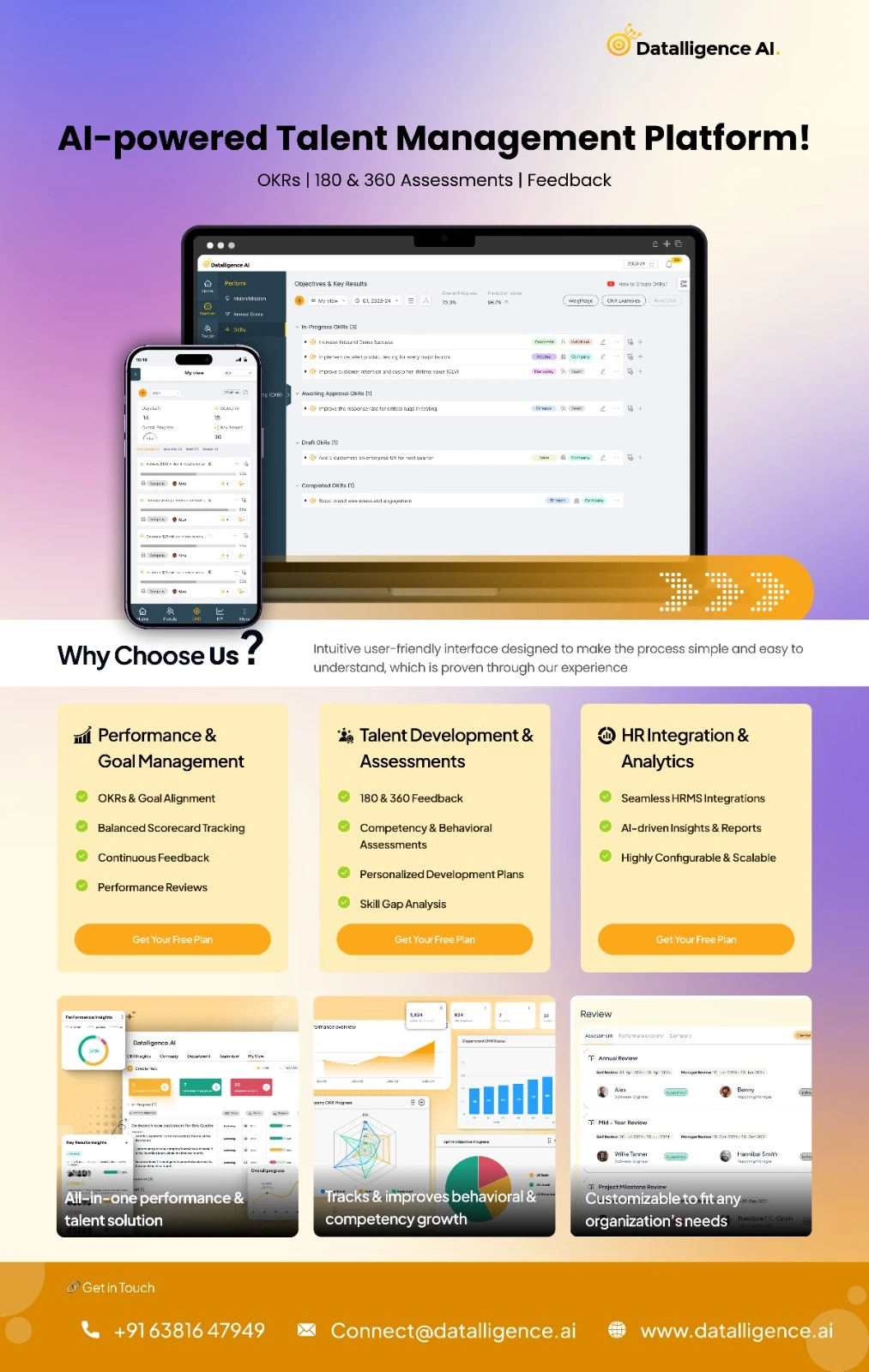In today’s fast-paced and highly competitive business world, productivity has become a crucial factor in determining the success of modern workplaces.
Did you know that🤯, An average employee is productive for only 2hrs and 53 mins where employees get interrupted about 7 times, with each interruption taking up about 5 minutes of their working time?
One effective solution to tackle the challenges of workplace productivity is by utilizing OKR goal-setting software, which can help businesses establish clear objectives and key results, align their employees’ efforts towards common goals, and track their progress towards achieving them. However, despite the benefits of this tool, there are still several challenges that businesses may face in optimizing their productivity.
Whether you’re a manager looking to boost team productivity, or an employee seeking to enhance your output, read on to discover how to tackle the toughest productivity obstacles of the 21st century.
What Is Employee Productivity
Employee productivity refers to the level of output an employee generates about the number of resources (time, energy, money, etc.) they put into their work.
Here are some key points to help explain what employee productivity is:
- Employee productivity is a measure of how efficiently and effectively employees are using their time and resources to accomplish their tasks and goals.
- It is often measured in terms of output or outcomes, such as the number of products produced, the amount of revenue generated, or the level of customer satisfaction achieved.
- Various factors can influence employee productivity, including the work environment, the quality of management and supervision, employee motivation and engagement, and the availability of resources and technology.
- Improving employee productivity can have a significant impact on a company’s bottom line, as it can increase output, reduce costs, and improve customer satisfaction.
- To improve employee productivity, companies can implement various strategies, such as providing training and development opportunities, optimizing work processes, setting clear goals and expectations, offering incentives and rewards, and fostering a positive work culture.
Read our latest blog where we talk about the 10 Main Features of Employee Performance Software that Increase Productivity and Engagement.
Ultimately, employee productivity is crucial for businesses to remain competitive and successful, as it helps them to achieve their goals and meet the needs of their customers and stakeholders.
Here are some reasons why employee motivation is important:
Improved Performance Management
When employees are motivated, they tend to perform better and produce high-quality work. Motivated employees take pride in their work and are more likely to meet or exceed their targets. This, in turn, leads to better performance management as managers can set more challenging goals and monitor progress more effectively.
Increased Employee Engagement
Motivated employees are more engaged with their work and the organization. They are more likely to be committed to the company’s mission, vision, and values, and to contribute to a positive workplace culture. Engaged employees are also more likely to stay with the company and be loyal to the organization, which can reduce turnover rates and save on recruitment costs.
Increased Productivity
Employee motivation leads to increased productivity. When employees are motivated, they are more likely to work harder, smarter, and faster. Motivated employees are also more willing to take on additional responsibilities, which can lead to improved efficiency and effectiveness in the workplace.
Enhanced Job Satisfaction
Motivated employees are more satisfied with their jobs and are less likely to experience burnout or stress. When employees are happy and engaged in their work, they are more likely to have a positive attitude toward their work, colleagues, and customers. This can lead to higher levels of job satisfaction and a better work-life balance.
Improved Customer Satisfaction
Motivated employees can positively impact customer satisfaction levels. When employees are motivated, they are more likely to provide exceptional customer service, which can lead to customer loyalty and repeat business. Happy customers can be a key driver of business success, so it’s essential to have motivated employees who can deliver a positive customer experience.
Improved business outcomes
Ultimately, employee motivation can lead to improved business outcomes, including higher revenue, increased profitability, and greater market share. When employees are motivated, they tend to be more productive, engaged, and committed to achieving business goals, resulting in improved performance and greater success for the organization.
10 Factors affecting productivity at Modern Workplaces

Clear goals and objectives 🎯
Employees need to have a clear understanding of their goals and objectives to be productive. When goals are well-defined, employees know what is expected of them and can prioritize their work accordingly.
For example, a sales representative who knows their monthly sales target is more likely to be productive than one who doesn’t.
If you are looking for goal-setting software to increase productivity, Have a go at our latest blog where we talk about the best goal-setting software.
Performance management 📈
Effective performance management is critical for employee productivity. It includes setting goals, providing feedback, and recognizing good performance.
For example, a manager who sets clear performance goals for their team and provides regular feedback is likely to have more productive employees.
Positive work environment 😊
A positive work environment is essential for employee productivity. It includes factors such as good lighting, comfortable temperature, ergonomically designed furniture, and a clean workspace. When employees feel comfortable and safe at work, they are more likely to be productive.
Adequate resources 🛠️
Employees need the right tools and resources to be productive. This includes access to technology, equipment, and materials. For example, a graphic designer who has access to the latest design software and a powerful computer is likely to be more productive than one who doesn’t.
Effective communication 🗣️
Communication is critical for employee productivity. Employees need to know what is expected of them, receive feedback on their work, and be able to communicate their needs and concerns. For example, a manager who provides regular feedback to their team and listens to their feedback is likely to have more productive employees.
Training and development 📚
Ongoing training and development are essential for employee productivity. When employees have opportunities to learn new skills and improve their knowledge, they become more effective at their jobs. For example, a software developer who receives training in the latest programming language is likely to be more productive than one who doesn’t.
Work-life balance ⚖️
Employees need a balance between their work and personal lives to be productive. When employees have the flexibility to manage their time and attend to personal responsibilities, they are more likely to be productive. For example, an employee who has the flexibility to work from home or adjust their work schedule to attend a family event is likely to be more productive than one who doesn’t.
Employee engagement and recognition 🏆
Employees who are recognized and rewarded for their work are more likely to be productive. This includes both financial and non-financial rewards, such as bonuses, promotions, and public recognition. For example, an employee who receives a bonus for meeting their performance goals is likely to be more productive in the future.
Health and well-being 🌿
Employee health and well-being are critical for productivity. Employers need to provide access to health benefits and support programs to help employees manage their physical and mental health.
For example, an employee who has access to an employee assistance program to help manage their stress is likely to be more productive than one who doesn’t.
Leadership and management 🤝
Effective leadership and management are critical for employee productivity. Managers need to lead by example, provide direction, and support their teams. For example, a manager who provides clear direction and support to their team is likely to have more productive employees.
The Cost Of Disengaged Employees
Disengaged employees can have a significant impact on an organization’s bottom line. One of the most significant costs of disengagement is reduced productivity.
According to Gallup disengaged employees cost their company the equivalent of 18% of their annual salary.
When employees are not engaged in their work, they are less likely to perform their jobs to the best of their abilities, which can lead to decreased productivity and efficiency.
This can result in missed deadlines, poor-quality work, and decreased customer satisfaction. Disengaged employees may also be less likely to collaborate with their colleagues or take on additional responsibilities, which can further hamper productivity. Over time, these productivity losses can add up and negatively impact the organization’s financial performance.
Conclusion
By addressing these factors, organizations can create a more productive workplace and improve the overall performance of their employees. Additionally, it is important for organizations to regularly evaluate and adapt to changes in the workplace and the needs of their employees to maintain and enhance productivity over time. Talk to our Performance coaches and experts and gain their insights on this topic or try Datalligence for “free”
FAQs
1. What are the factors affecting work productivity?
Several factors influence workplace productivity, including clear goal-setting, effective communication, access to necessary resources, employee motivation, and a supportive work environment. External elements like technology, organizational culture, and management practices also play a role. When these factors align positively, employees can focus on their tasks and perform efficiently.
2. What are modern workplace factors?
Modern workplace factors include flexibility (such as remote work options), technology integration, employee well-being programs, and diversity and inclusion initiatives. Additionally, there is an increasing focus on aligning personal and organizational goals, fostering collaboration, and providing learning and development opportunities. These factors contribute to a more engaging and productive workplace environment.
3. How does employee motivation impact productivity?
Employee motivation is closely tied to productivity. Motivated employees tend to work more efficiently, take pride in their tasks, and produce better-quality work. This positive drive leads to greater engagement, willingness to assume responsibility, and alignment with company goals, resulting in higher productivity and improved performance outcomes.
4. How can OKR software improve productivity?
OKR software enhances productivity by allowing teams to set clear, measurable goals, track progress, and align their efforts with organizational objectives. This transparency keeps everyone focused on priority tasks, fosters accountability, and enables real-time adjustments, ultimately supporting a culture of continuous improvement.
5. What is employee productivity, and why is it important?
Employee productivity measures the output produced relative to the resources (such as time and effort) invested in tasks. High productivity is crucial for businesses as it increases output, lowers operational costs, and leads to customer satisfaction, helping companies achieve their goals and remain competitive.
6. What are the benefits of increased employee engagement?
Increased engagement brings various benefits, including reduced turnover, higher job satisfaction, and improved productivity. Engaged employees are more likely to be loyal, contribute positively to the work culture, and deliver excellent customer service. OKR tools also support engagement by showing employees how their efforts impact broader company success.











